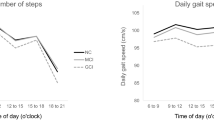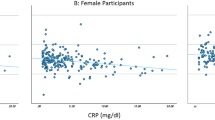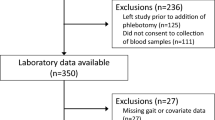Abstract
Background/Objectives:
Gait is an important health indicator, relating strongly to the risk of falling, morbidity and mortality. In a community-dwelling population, we investigated associations of alcohol, coffee and tobacco consumption with gait.
Subjects/Methods:
Two thousand forty-six non-demented participants from the Rotterdam Study underwent gait assessment by electronic walkway. We measured gait velocity and Global Gait, which is the average of seven gait domains: Rhythm, Phases, Variability, Pace, Tandem, Turning and Base of Support. Alcohol, coffee and tobacco consumption was assessed by questionnaires. With analysis of covariance, we investigated associations of consumption of alcoholic beverages, coffee consumption and smoking with Global Gait, gait velocity and the seven individual gait domains.
Results:
In all, 81.9% of participants drank alcohol, 92.4% drank coffee, 17.3% were current smokers and 50.9% were past smokers. Moderate alcohol consumption (1–3 glasses per day) associated with better gait, as measured by Global Gait (0.20 standard deviations (s.d.) (95% confidence interval: 0.10; 0.31)), gait velocity (2.65 cm/s (0.80; 4.50)), Rhythm and Variability. Consuming high amounts of coffee (>3 cups per day) associated with better Global Gait (0.18 s.d. (0.08; 0.28)), gait velocity (2.63 cm/s (0.80; 4.45)), Pace, Turning and Variability. Current smoking associated with worse Global Gait (−0.11 s.d. (−0.21; 0.00)), gait velocity (−3.47 cm/s (−5.33; −1.60)), Rhythm and Pace, compared with non-smokers.
Conclusions:
In a community-dwelling population, consuming >1 cup of coffee and 1–3 glasses of alcohol relate to better gait, whereas smoking is related to worse gait. Further studies are required to evaluate whether interventions targeting substance consumption may aid to prevent or reduce gait deterioration and thereby related health problems.
This is a preview of subscription content, access via your institution
Access options
Subscribe to this journal
Receive 12 print issues and online access
$259.00 per year
only $21.58 per issue
Buy this article
- Purchase on Springer Link
- Instant access to full article PDF
Prices may be subject to local taxes which are calculated during checkout

Similar content being viewed by others
References
Cano-Marquina A, Tarin JJ, Cano A . The impact of coffee on health. Maturitas 2013; 75: 7–21.
Stringhini S, Dugravot A, Shipley M, Goldberg M, Zins M, Kivimaki M et al. Health behaviours, socioeconomic status, and mortality: further analyses of the British Whitehall II and the French GAZEL prospective cohorts. PLoS Med 2011; 8: e1000419.
Karlamangla AS, Sarkisian CA, Kado DM, Dedes H, Liao DH, Kim S et al. Light to moderate alcohol consumption and disability: variable benefits by health status. Am J Epidemiol 2009; 169: 96–104.
Paul CA, Au R, Fredman L, Massaro JM, Seshadri S, Decarli C et al. Association of alcohol consumption with brain volume in the Framingham study. Arch Neurol 2008; 65: 1363–1367.
O'Keefe JH, Bybee KA, Lavie CJ . Alcohol and cardiovascular health: the razor-sharp double-edged sword. J Am Coll Cardiol 2007; 50: 1009–1014.
Ding M, Bhupathiraju SN, Satija A, van Dam RM, Hu FB . Long-term coffee consumption and risk of cardiovascular disease: a systematic review and a dose-response meta-analysis of prospective cohort studies. Circulation 2014; 129: 643–659.
Messner B, Bernhard D . Smoking and cardiovascular disease: mechanisms of endothelial dysfunction and early atherogenesis. Arterioscler Thromb Vasc Biol 2014; 34: 509–515.
Swan GE, Lessov-Schlaggar CN . The effects of tobacco smoke and nicotine on cognition and the brain. Neuropsychol Rev 2007; 17: 259–273.
Krenz M, Korthuis RJ . Moderate ethanol ingestion and cardiovascular protection: from epidemiologic associations to cellular mechanisms. J Mol Cell Cardiol 2012; 52: 93–104.
Arab L, Khan F, Lam H . Epidemiologic evidence of a relationship between tea, coffee, or caffeine consumption and cognitive decline. Adv Nutr 2013; 4: 115–122.
Ramsay S, Ebrahim S, Whincup P, Papacosta O, Morris R, Lennon L et al. Social engagement and the risk of cardiovascular disease mortality: results of a prospective population-based study of older men. Ann Epidemiol 2008; 18: 476–483.
Bolego C, Poli A, Paoletti R . Smoking and gender. Cardiovasc Res 2002; 53: 568–576.
Lantz PM, House JS, Lepkowski JM, Williams DR, Mero RP, Chen J . Socioeconomic factors, health behaviors, and mortality: results from a nationally representative prospective study of US adults. JAMA 1998; 279: 1703–1708.
Abellan van Kan G, Rolland Y, Andrieu S, Bauer J, Beauchet O, Bonnefoy M et al. Gait speed at usual pace as a predictor of adverse outcomes in community-dwelling older people an International Academy on Nutrition and Aging (IANA) Task Force. J Nutr Health Aging 2009; 13: 881–889.
Cesari M . Role of gait speed in the assessment of older patients. JAMA 2011; 305: 93–94.
Watson NL, Sutton-Tyrrell K, Youk AO, Boudreau RM, Mackey RH, Simonsick EM et al. Arterial stiffness and gait speed in older adults with and without peripheral arterial disease. Am J Hypertens 2011; 24: 90–95.
Rosano C, Longstreth WT Jr, Boudreau R, Taylor CA, Du Y, Kuller LH et al. High blood pressure accelerates gait slowing in well-functioning older adults over 18-years of follow-up. J Am Geriatr Soc 2011; 59: 390–397.
Callisaya ML, Blizzard L, McGinley JL, Schmidt MD, Srikanth VK . Sensorimotor factors affecting gait variability in older people—a population-based study. J Gerontol A 2010; 65: 386–392.
Callisaya ML, Blizzard L, Schmidt MD, McGinley JL, Lord SR, Srikanth VK . A population-based study of sensorimotor factors affecting gait in older people. Age Ageing 2009; 38: 290–295.
Verlinden VJ, van der Geest JN, Hofman A, Ikram MA . Cognition and gait show a distinct pattern of association in the general population. Alzheimers Dement 2014; 10: 328–335.
Shinkai S, Watanabe S, Kumagai S, Fujiwara Y, Amano H, Yoshida H et al. Walking speed as a good predictor for the onset of functional dependence in a Japanese rural community population. Age Ageing 2000; 29: 441–446.
Montero-Odasso M, Schapira M, Soriano ER, Varela M, Kaplan R, Camera LA et al. Gait velocity as a single predictor of adverse events in healthy seniors aged 75 years and older. J Gerontol A 2005; 60: 1304–1309.
Maki BE . Gait changes in older adults: predictors of falls or indicators of fear. J Am Geriatr Soc 1997; 45: 313–320.
Studenski S, Perera S, Patel K, Rosano C, Faulkner K, Inzitari M et al. Gait speed and survival in older adults. JAMA 2011; 305: 50–58.
Verlinden VJ, van der Geest JN, Hoogendam YY, Hofman A, Breteler MM, Ikram MA . Gait patterns in a community-dwelling population aged 50 years and older. Gait Posture 2013; 37: 500–505.
Fein G, Greenstein D . Gait and balance deficits in chronic alcoholics: no improvement from 10 weeks through 1 year abstinence. Alcohol Clin Exp Res 2013; 37: 86–95.
Hofman A, Darwish Murad S, van Duijn CM, Franco OH, Goedegebure A, Ikram MA et al. The Rotterdam Study: 2014 objectives and design update. Eur J Epidemiol 2013; 28: 889–926.
Feunekes GI, Van Staveren WA, De Vries JH, Burema J, Hautvast JG . Relative and biomarker-based validity of a food-frequency questionnaire estimating intake of fats and cholesterol. Am J Clin Nutr 1993; 58: 489–496.
Goldbohm RA, van den Brandt PA, Brants HA, van't Veer P, Al M, Sturmans F et al. Validation of a dietary questionnaire used in a large-scale prospective cohort study on diet and cancer. Eur J Clin Nutr 1994; 48: 253–265.
Donders-Engelen MR, Heijden LJMvd, Hulshof KFAM . Maten, gewichten en codenummers. Wageningen Agricultural University: : The Netherlands,, 1997.
NEVO-tabel. Nederlands Voedingsstoffenbestand 2011 (Dutch Food Composition Table 2011). Stichting Nederlands Voedingsstoffenbestand. Den Haag: Voedingscentrum, 2011.
Fries JF, Spitz PW, Young DY . The dimensions of health outcomes: the health assessment questionnaire, disability and pain scales. J Rheumatol 1982; 9: 789–793.
Brach JS, Perera S, Studenski S, Newman AB . The reliability and validity of measures of gait variability in community-dwelling older adults. Arch Phys Med Rehabil 2008; 89: 2293–2296.
de Bruijn RF, Akoudad S, Cremers LG, Hofman A, Niessen WJ, van der Lugt A et al. Determinants, MRI correlates, and prognosis of mild cognitive impairment: the Rotterdam Study. J Alzheimers Dis 2014; 42, (suppl. 3) S239–S249.
Freedman LS, Schatzkin A, Midthune D, Kipnis V . Dealing with dietary measurement error in nutritional cohort studies. J Natl Cancer Inst 2011; 103: 1086–1092.
Chikritzhs T, Stockwell T, Naimi T, Andreasson S, Dangardt F, Liang W . Has the leaning tower of presumed health benefits from 'moderate' alcohol use finally collapsed? Addiction 2015; 110: 726–727.
Au Yeung SL, Jiang CQ, Cheng KK, Liu B, Zhang WS, Lam TH et al. Evaluation of moderate alcohol use and cognitive function among men using a Mendelian randomization design in the Guangzhou biobank cohort study. Am J Epidemiol 2012; 175: 1021–1028.
Holmes MV, Dale CE, Zuccolo L, Silverwood RJ, Guo Y, Ye Z et al. Association between alcohol and cardiovascular disease: Mendelian randomisation analysis based on individual participant data. BMJ 2014; 349: g4164.
Boleda MD, Saubi N, Farres J, Pares X . Physiological substrates for rat alcohol dehydrogenase classes: aldehydes of lipid peroxidation, omega-hydroxyfatty acids, and retinoids. Arch Biochem Biophys 1993; 307: 85–90.
Glymour MM . Alcohol and cardiovascular disease. BMJ 2014; 349: g4334.
Kang G, Bae KY, Kim SW, Kim J, Shin HY, Kim JM et al. Effect of the allelic variant of alcohol dehydrogenase ADH1B*2 on ethanol metabolism. Alcohol Clin Exp Res 2014; 38: 1502–1509.
Dite W, Temple VA . Development of a clinical measure of turning for older adults. Am J Phys Med Rehabil 2002; 81: 857–866.
Verghese J, Holtzer R, Lipton RB, Wang C . Quantitative gait markers and incident fall risk in older adults. J Gerontol A 2009; 64: 896–901.
Acknowledgements
The Rotterdam Study is sponsored by the Erasmus Medical Centre and Erasmus University Rotterdam, The Netherlands Organisation for Scientific Research (NWO), The Netherlands Organisation for Health Research and Development (ZonMW), The Research Institute for Diseases in the Elderly (RIDE), The Netherlands Genomics Initiative, the Ministry of Education, Culture and Science, the Ministry of Health, Welfare and Sports, the European Commission (DG XII) and the Municipality of Rotterdam. Further support was obtained from the Institute for Scientific Information on Coffee (ISIC). None of the funding sources had any involvement in the collection, analysis, writing, interpretation or decision to submit the manuscript for publication.
Author Contributions
MAI, JCK-dJ, AH, OHF and JNvdG designed the study. VJAV collected and analysed the data. VJAV, AM, MAI and JNvdG drafted the manuscript. All authors had an important role in interpreting the results and critically revised the manuscript for important intellectual content. All authors have approved the final version of the manuscript. The corresponding author confirms that he has had full access to the data in the study and final responsibility for the decision to submit the manuscript for publication.
Author information
Authors and Affiliations
Corresponding author
Ethics declarations
Competing interests
The authors declare no conflict of interest.
Additional information
Supplementary Information accompanies this paper on European Journal of Clinical Nutrition website
Rights and permissions
About this article
Cite this article
Verlinden, V., Maksimovic, A., Mirza, S. et al. The associations of alcohol, coffee and tobacco consumption with gait in a community-dwelling population. Eur J Clin Nutr 70, 116–122 (2016). https://doi.org/10.1038/ejcn.2015.120
Received:
Revised:
Accepted:
Published:
Issue Date:
DOI: https://doi.org/10.1038/ejcn.2015.120



